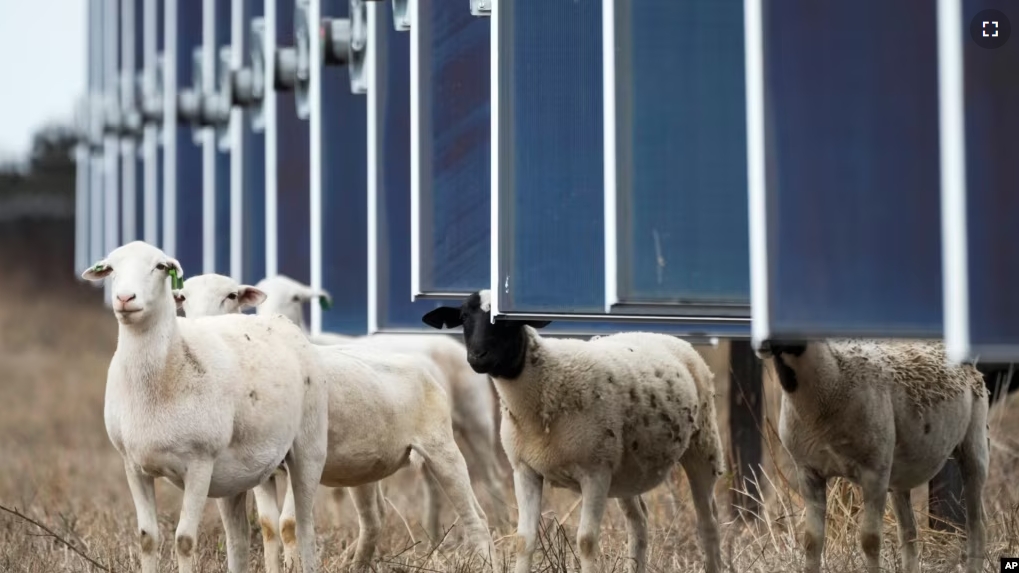A group of sheep on farmland in the American state of Texas work together to complete a job: eating the grass growing beneath hundreds of solar panels.
Sheep have become a symbol of a growing solar industry as large-scale solar farms appear across the United States.
Solar grazing
In Milam County, Texas, SB Energy operates the fifth-largest solar project in the country. It can produce 900 megawatts of power across 1,618 hectares.
So, how does the company deal with all the grass that grows on such a large piece of land? It deploys about 3,000 sheep that keep the grass cover low. Sheep, unlike devices such as lawnmowers, can fit between small spaces and work in all kinds of weather conditions.
The work of the sheep, and sometimes other animals, is called solar grazing. It is considered part of the larger idea of agrivoltaics — the use of land for both solar energy production and agriculture.
The U.S. Department of Agriculture suggests that solar grazing may help the environment in several ways. These include making grassy areas safer for wild animals, like nesting ground birds, and by reducing fuel use and air pollution.
Agrivoltaics is on the rise with more than 60 solar grazing projects in the U.S., the National Renewable Energy Laboratory says. The American Solar Grazing Association says 27 states take part in solar grazing.

A sunny opportunity
Putting the animals to work on solar fields also provides some help to the sheep and wool market, which has struggled in recent years. The number of sheep and lambs in Texas fell to 655,000 in January 2024, a 4 percent drop from the year before. That information comes from the most recent data from the U.S. Department of Agriculture.
Because solar fields use sunny, flat land that is often good for animals to eat grass on, the power plants have been used in cooperation with farmers rather than against them.
Sheep farmer JR Howard accidentally found himself in the middle of Texas’ move to clean energy. In 2021, he and his family began working with solar farms. Howard’s sheep ate the grass on these large areas of land.

What was once a small business has turned into a larger operation with more than 8,000 sheep and 26 employees.
“Just the growth has been kind of crazy for us,” said Howard, who named his company Texas Solar Sheep. “It’s been great for me and my family.”
Following the herd
Some agriculture experts say Howard’s success shows how solar farms have become a big help for some ranchers.
Reid Redden is a sheep farmer and solar vegetation manager in San Angelo, Texas. Redden said a successful sheep business requires agricultural land that has become increasingly hard to find.
“Solar grazing is probably the biggest opportunity that the sheep industry had in the United States in several generations,” Redden said.
Redden suggested that people in the rural communities near where he raises sheep have been very positive about solar grazing.
Agrivoltaics itself is not new. Solar farms use a lot of land and require a lot of space that could be used for food production.
Agrivoltaics helps with the problem by permitting the two industries to coexist, whether growing food or caring for livestock.
There is a lot still unknown about the full effects of solar grazing, said Nuria Gomez-Casanovas of Texas A&M University.
Not enough studies have been done to know the long-term environmental effects, such as how good the soil will be for future agriculture. However, Gomez-Casanovas suspects solar grazing may improve sheep productivity.
“We really have more questions than answers,” Gomez-Casanovas said.
I’m John Russell.
Nadia Lathan reported on this story for the Associated Press. John Russell adapted it for VOA Learning English.
________________________________________________
Words in This Story
solar panel – n. a battery of solar cells
symbol – n. something that stands for or suggests something else by reason of relationship, association, convention, or accidental resemblance
wool – n. the soft and usually thick undercoat of hairy mammals (especially sheep)
rancher – n. one who owns or works on a large farm that raises sheep, cows, horses, etc.
vegetation – n. plant cover or plant life
opportunity – n. a good chance for advancement or progress
